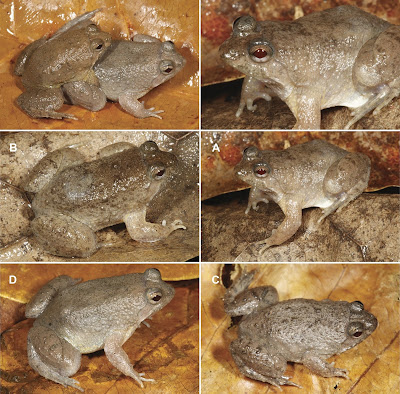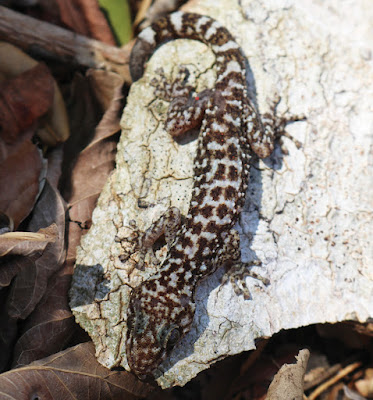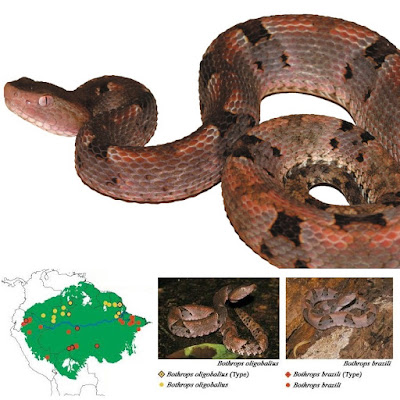[Most Recent Entries] [Calendar View]
Tuesday, March 16th, 2021
| Time | Event | ||||||
| 2:02a | [Herpetology • 2021] Phrynoglossus myanhessei • A Taxonomic Revision of the Genus Phrynoglossus (Anura, Dicroglossidae) in Indochina with the Description of A New Species and Comments on the Classification within Occidozyginae
Abstract We revise the frogs of the genus Phrynoglossus from Indochina based on data of external morphology, bioacoustics and molecular genetics. The results of this integrative study provide evidence for the recognition of three distinct species, one of which we describe as new. Phrynoglossus martensii has a vast geographic distribution from central and southern Thailand across southern China to Vietnam, Laos, and Cambodia. Phrynoglossus myanhessei sp. nov. is distributed in central Myanmar whereas Phrynoglossus magnapustulosus is restricted to the Khorat Plateau, Thailand. These three species occur in allopatry and differ in their mating calls, external morphology, and in genetic distances of the 16S gene of 3.8–5.9%. Finally, we discuss and provide evolutionary evidence for the recognition of Phrynoglossus as a genus distinct from Occidozyga. Members of both genera form reciprocal monophyletic groups in our analyses of mtDNA data (16S) and are well differentiated from each other in morphology and ecology. Furthermore, they differ in the amplexus mode with Phrynoglossus having an inguinal amplexus whereas it is axillary in Occidozyga. We further provide a de novo draft genome of the holotype based on short-read sequencing technology to a coverage of 25-fold. This resource will permanently link the genetic characterization of the species to the name-bearing type specimen. Key words: amplexus mode, bioacoustics, cryptic species diversity, Dicroglossidae, genome, Khorat Plateau, Myanmar, new species, Occidozyga, Phrynoglossus myanhessei sp. n., Thailand Phrynoglossus myanhessei Köhler, Vargas, Than & Thammachoti, sp. nov. Diagnosis: A species of the genus Phrynoglossus as defined above that differs from all mainland Southeast Asian congeners by having (1) a large body size (males 22.0–27.4 mm; females 28.4–31.3 mm); (2) relatively small tympanum (ratio TYD/SVL 0.48–0.92); and (3) call duration of male advertisement call 85–114 ms. Phrynoglossus myanhessei differs from its congeners in Indochina (i.e., P. martensii and P. magnapustulosus) in the male advertisement call, most obvious in call duration (85–114 ms in P. myanhessei, 32–52 ms in P. martensii, 243–437 ms in P. magnapustulosus) and dominant frequency (2454–2885 Hz in P. myanhessei, 3338–3962 Hz in P. martensii, 3187–3790 Hz in P. magnapustulosus). Etymology “Myan” is Myanmar’s abbreviated name and was chosen because this species is endemic to Myanmar as far as we know. “hessei” was chosen in recognition of the long-term support and funding of Senckenberg by the German State of Hesse. In combination, the species name myanhessei reflects the long-term productive collaboration of researchers from Hesse and Myanmar in the field of herpetology. Natural history notes At the type locality, the specimens were collected at night in a patch of muddy grass area, partly open, partly covered by bushes and low trees. The frogs were sitting at the edge of small shallow temporary water bodies. Gunther Köhler, Joseph Vargas, Ni Lar Than, Tilman Schell, Axel Janke, Steffen U. Pauls and Panupong Thammachoti. 2021. A Taxonomic Revision of the Genus Phrynoglossus in Indochina with the Description of A New Species and Comments on the Classification within Occidozyginae (Amphibia, Anura, Dicroglossidae). Vertebrate Zoology. 71: 1-26. DOI: 10.3897/vertebrate-zoology.71.e60312 | ||||||
| 7:32a | [Herpetology • 2021] Phyllodactylus cleofasensis • A New Species of Leaf-toed Gecko (Phyllodactylidae, Phyllodactylus) from María Cleofas Island, Nayarit, Mexico
Abstract We describe a new species of leaf-toed gecko of the genus Phyllodactylus from María Cleofas Island, the smallest island of Tres Marías Archipelago, Nayarit, México. Genomic, phylogenomic, and morphological evidence support that the new species presents a unique combination of diagnostic characters. Morphologically, the new species has a high number of tubercles, head to tail (mean 47), longitudinal ventral scales (mean 61), and third labial–snout scales (mean 26). Gene flow tests revealed the genetic isolation of insular populations from mainland counterparts. In addition, we confirmed the non-monophyly of P. homolepidurus and P. nolascoensis, and we show that the taxon P. t. saxatilis is a complex; therefore, we propose taxonomic changes within the saxatilis clade. The discovery of this new insular endemic species highlights the urgency of continued exploration of the biological diversity of island faunas of Mexico. Keywords: Endemic gecko, genomics, insular species, morphological traits, Tres Marías Archipelago
Phyllodactylus cleofasensis sp. nov. Phyllodactylus tuberculosus (in part) Wiegmann 1835 (Stejneger 1899) Phyllodactylus lanei (in part) Smith 1935 (Zweifel 1960) P. tuberculosus saxatilis (in part) Dixon 1964 (McDiarmid et al. 1976; Casas-Andreu 1992; Woolrich-Piña et al. 2016) Common name: María Cleofas leaf-toed Gecko, Salamanquesa de la Isla María Cleofas. Diagnosis: Phyllodactylus cleofasensis is a species of medium to large body size. Snout-vent length of P. cleofasensis measured during fieldwork ranged from 44.8 to 77.0 mm (mean 59.5 mm). Concerning body size, P. cleofasensis differs (in mean size) from P. magnus (73.03), P. nolascoensis (56.29), P. partidus (55.12) and P. saxatilis (65.44). Phyllodactylus cleofasensis has a white venter, variable dorsal coloration, and a greater number of paravertebral dorsal tubercles (mean 47.89). Three meristic characters mainly differentiate P. cleofasensis from the rest of the species of the saxatilis clade (P. saxatilis, P. nolascoensis, P. partidus, P. homolepidurus and Phyllodactylus sp.) (Table 3): paravertebral dorsal tubercles from head to tail (mean 47.89); number of scales across the snout, starting from the 3rd labial scale (mean 26.5); and number of longitudinal ventral scales from an imaginary line of the forelimbs to the cloacal opening (mean 61). Phyllodactylus cleofasensis has the highest values of the mentioned characters, while the rest of the studied species presented lower counts compared to other Phyllodactylus species in Mexico (Tables 2 and 3). The new species has the second highest mean number of dorsal tubercles after P. delcampi (63.4). Other Phyllodactylus species have fewer mean dorsal tubercles (P. paucituberculatus, 28.7; P. duellmani, 37.1; P. bordai, 32.9; P. davisi, 41.6; P. muralis, 33.1; P. homolepidurus, 35.9; P. xanti, 37; P. lanei, 32.4; P. papenfussi, 33.2; P. isabelae, 32.3; P. lupitae, 28.8; P. rupinus, 28; P. benedettii, 28.8; and P. kropotkini, 28.4). Regarding the number of scales crossing the snout, P. cleofasensis has a very similar number of scales to P. muralis (26.1) and P. lupitae (25.5); lower counts occur in P. unctus (21.7), P. paucituberculatus (19.5), P. duellmani (19.9), P. delcampi (21), P. bordai (19.4), P. davisi (23.7), P. muralis (26.1), P. homolepidurus (22.5), P. xanti (16.5), P. lanei (21.6), P. papenfussi (17.8), P. isabelae (21.1), P. rupinus (20.6), P. benedettii (22), and P. kropotkini (20.2). Concerning ventral scales, P. cleofasensis has a mean of 61, similar to three species of the lanei clade (or clade I), namely, P. lupitae (61.5), P. rupinus (62) and P. lanei (62.86). The rest of the Phyllodactylus in Mexico have less than 61 scales: P. kropotkini (60), P. benedettii (59.71), P. xanti (58.75), P. angelensis (56.75), P. davisi (55.5), P. magnus (55.3), P. partidus (55.2), P. saxatilis (55), P. santacruzensis (54), P. muralis (53.9), P. isabelae (53.85), P. nolascoensis (52.75), P. homolepidurus (52.5), P. bordai (51.91), P. bugastrolepis (51.57), P. duellmani (48.75), P. paucituberculatus (48.66), and P. unctus (48.5). Etymology: Specific epithet is taken from the type locality María Cleofas Island, with the Latin suffix -ensis meaning, “originating from.” Specific epithet is masculine, in agreement with the gender of Phyllodactylus.
Tonatiuh Ramírez-Reyes, Ilse K. Barraza-Soltero, Jose Rafael Nolasco-Luna, Oscar Flores-Villela and Armando H. Escobedo-Galván. 2021. A New Species of Leaf-toed Gecko (Phyllodactylidae, Phyllodactylus) from María Cleofas Island, Nayarit, Mexico. ZooKeys. 1024: 117-136. DOI: 10.3897/zookeys.1024.60473 | ||||||
| 9:12a | [Herpetology • 2021] Bothrops oligobalius • Molecular and Phenotypic Data reveal A New Amazonian Species of Pit Vipers (Serpentes: Viperidae: Bothrops)
ABSTRACT Recent genetic studies have found unclear species boundaries and evidence of undescribed diversity in the poorly studied jararacussu species group within Bothrops. In this contribution, we investigate phenotypic and genetic diversity in the Amazonian snake Bothrops brazili to test previous assertions of unrecognised species diversity within this taxon. Our phylogenetic results and inferences of independently evolving lineages based on molecular data recover two divergent clades within B. brazili, one restricted to areas north and another to areas south of the Amazon River. Phylogenetic relationships between these lineages and other species in the jararacussu species group reveal B. brazili to be paraphyletic, with the northern clade inferred as sister to a clade composed of Atlantic Forest taxa (B. jararacussu, B. muriciensis, B. pirajai). External morphology (number of ventral and subcaudal scales) and colouration patterns (lateral trapezoidal marks) consistently separate the two lineages of B. brazili. We therefore recognise and describe the northern lineage as a new species of Bothrops, improving our knowledge of species diversity within a medically important clade of venomous South American snakes. KEYWORDS: Amazonia, Amazon River, Bothrops brazili, B. jararacussu, B. pirajai, B. muriciencis, species delimitation
Bothrops oligobalius sp. nov. Diagnosis:(1) A robust body species, SVL = 245–805 mm, (2) short tail, TL = 35–113 mm; (3) 23–27 dorsals on the first third of the body; (4) 23–25 dorsals at midbody; (5) 18–21 dorsals on the last third of the body; (6) 156–164 ventrals in females (median = 160) and 154–159 in males (median = 156); (7) anal scale not divided; (8) 42–48 paired subcaudals in females (median = 44.5) and 47–52 in males (median = 48.8); (9) 9–13 lateral trapezoidal marks in each side (median = 11,01 and 11,7 on the right and left side, respectively); (10) postorbital stripe absent or poorly marked; (11) eight supralabials; (12) 10–12 infralabials; (13) second supralabial fused to the prelacunal; (14) belly checkered; (15) absence of vertebral stripe. Etymology: The specific name derives from the Greek oligos (few) and balios (spotted, dappled). The name is a reference to the smaller number of lateral trapezoidal marks on the body compared to Bothrops brazili, a name now restricted to the populations south of the Amazon River. Francisco Dal Vechio, Ivan Prates, Felipe G. Grazziotin, Roberta Graboski and Miguel Trefaut Rodrigues. 2021. Molecular and Phenotypic Data reveal A New Amazonian Species of Pit Vipers (Serpentes: Viperidae: Bothrops). Journal of Natural History. 2415-2437. DOI: 10.1080/00222933.2020.1845835 |
| << Previous Day |
2021/03/16 [Calendar] |
Next Day >> |














